The Prediction of Antioxidant Q-Markers for Angelica dahurica Based on the Dynamics Change in Chemical Compositions and Network Pharmacology
Abstract
:1. Introduction
2. Results and Discussion
2.1. Analysis of Chemical Constituents in Different Parts of A. dahurica
2.2. Analysis of Main Chemical Components in Different Parts of A. dahurica at Different Stages
2.2.1. Analysis of Chemical Components in the Roots of A. dahurica in Different Periods
2.2.2. Analysis of Chemical Components in the Stems of A. dahurica in Different Periods
2.2.3. Analysis of Chemical Components in the Leaves of A. dahurica in Different Periods
2.2.4. Analysis of the Difference in Compound Accumulation in Different Medicinal Parts of A. dahurica
2.3. Network Pharmacological Analysis
2.3.1. The Potential Q-Markers of A. dahurica
2.3.2. Q-Markers Targets and Antioxidant Targets
2.3.3. PPI Network of Potential Antioxidant Targets of A. dahurica
2.3.4. Enrichment of Antioxidant GO Function and Analysis of KEGG Pathway in A. dahurica
2.3.5. Molecular Docking
3. Materials and Methods
3.1. Materials and Reagents
3.2. Analyzing the Main Chemical Components in Various Parts of A. dahurica at Different Periods by GC-MS
3.2.1. Sample Solution Preparation
3.2.2. GC-MS Conditions
3.2.3. Data Analysis
3.3. Prediction and Analysis of Antioxidant Related Substances in A. dahurica Based on Network Pharmacology
3.3.1. Obtaining the Q-Markers of A. dahurica
3.3.2. Screening of Q-Markers Targets
3.3.3. Screening of Potential Targets for Antioxidant Activity
3.3.4. Protein Interaction Network Construction (PPI)
3.3.5. GO Enrichment Analysis and KEGG Pathway Analysis
3.3.6. Molecular Docking
4. Conclusions
Author Contributions
Funding
Institutional Review Board Statement
Informed Consent Statement
Data Availability Statement
Conflicts of Interest
Sample Availability
References
- Chinese Pharmacopoeia Commission. Pharmacopoeia of People’s Republic of China; China Medical Science and Technology Press: Beijing, China, 2020; Volume 1, p. 109. [Google Scholar]
- Zhao, D.Y.; Hao, Q.X.; Jin, Y.; Kang, L.P.; Liu, Y.; Guo, L.P. Research progress on biological characteristics and cultivation techniques of Angelica dahurica. Mod. Chin. Tradit. Med. 2015, 17, 1188–1192. [Google Scholar]
- Lu, Q. Comparative Study on the Growth Characteristics and Yield and Quality of Chuan Bai Zhi. Master’s Thesis, Chengdu University of TCM, Chengdu, China, 2009; p. 11. [Google Scholar]
- Wang, M.Y.; Jia, M.R.; Ma, Y.Y.; Jiang, G.H.; Tang, S.W.; Xia, L. Effects of different medicinal parts and different processing methods on the content of coumarins in Angelica dahurica. Tradit. Chin. Med. 2004, 27, 826–828. [Google Scholar]
- Zhang, W.L.; Zheng, K.Y.; Zhu, K.Y.; Zhan, J.Y.; Bi, C.W.; Chen, J.P.; Dong, T.X.; Choi, C.Y.; Lau, T.W.; Tsim, K.W. Chemical and biological assessment of angelica roots from different cultivated regions in a Chinese herbal decoction danggui buxue tang. Evid.-Based Complement. Altern. Med. 2013, 2013, 483286. [Google Scholar]
- Pang, X.; Jing, Y.; Li, P.; Qiu, X.; Zheng, Y.; Wang, Q.; Wu, L. Structural characterization and antioxidant activities of polysaccharides from A. dahurica as extracted by optimized ultrasonic-assisted method. Int. J. Food Prop. 2022, 25, 1635–1649. [Google Scholar] [CrossRef]
- Mehnaz, P.; Md, A.H.; Trishna, D.; Seung, Y.L.; Sa, R.P.; Beong, O.L. Antioxidant, anti-inflammatory and antiproliferative activity of A. dahurica root extracts. J. Food Biochem. 2014, 38, 281–292. [Google Scholar]
- Wang, H.; Wang, X.; Zhou, L.; Zhang, S.; An, L.; Bao, J.; Li, Z.; Sun, Y.; Li, Y.; Cui, J.; et al. Structural characteristics and in vitro and in vivo immunoregulatory properties of a gluco-arabinan from A. dahurica. Int. J. Biol. Macromol. 2021, 183, 90–100. [Google Scholar] [CrossRef] [PubMed]
- Zhang, Y.; Li, Z.; Wei, J.; Kong, L.; Song, M.; Zhang, Y.; Xiao, X.; Cao, H.; Jin, Y. Network pharmacology and molecular docking reveal the mechanism of A. dahurica against Osteosarcoma. Medicine 2022, 101, 2196. [Google Scholar] [CrossRef]
- Shu, P.; Li, J.; Fei, Y.; Zhu, H.; Yu, M.; Liu, A.; Niu, H.; Zou, S.; Wei, X.; Ju, Z.; et al. Isolation, structure elucidation, tyrosinase inhibitory, and antioxidant evaluation of the constituents from A. dahurica roots. J. Nat. Med. 2020, 74, 456–462. [Google Scholar] [CrossRef]
- Li, D.; Wu, L. Coumarins from the roots of A. dahurica cause anti-allergic inflammation. Exp. Ther. Med. 2017, 14, 874–880. [Google Scholar] [CrossRef] [Green Version]
- Zhao, H.; Feng, Y.L.; Wang, M.; Wang, J.J.; Liu, T.; Yu, J. The A. dahurica: A review of traditional uses, phytochemistry and pharmacology. Front. Pharmacol. 2022, 13, 896637. [Google Scholar] [CrossRef] [PubMed]
- Cheng, W.; Tao, W.; Limin, H.; Wen, L.; Jie, Z.; Huaizhen, H. Synthesis and fluorescent study of 5-phenyl furocoumarin derivatives as vasodilatory agents. Bioorg. Med. Chem. Lett. 2016, 26, 640–644. [Google Scholar]
- Li, B.; Zhang, X.; Wang, J.; Zhang, L.; Gao, B.; Shi, S.; Wang, X.; Li, J.; Tu, P. Simultaneous characterisation of fifty coumarins from the roots of Angelica dahurica by off-line two-dimensional high-performance liquid chromatography coupled with electrospray ionisation tandem mass spectrometry. Phytochem. Anal. PCA 2014, 25, 229–240. [Google Scholar] [CrossRef] [PubMed]
- Liu, J.; Liu, C.; Chen, H.; Cen, H.; Yang, H.; Liu, P.; Liu, F.; Ma, L.; Chen, Q.; Wang, L. Tongguan capsule for treating myocardial ischemia-reperfusion injury: Integrating network pharmacology and mechanism study. Pharm. Biol. 2023, 61, 437–448. [Google Scholar] [CrossRef] [PubMed]
- Deng, H.; Jiang, J.; Zhang, S.; Wu, L.; Zhang, Q.; Sun, W. Network pharmacology and experimental validation to identify the potential mechanism of Hedyotis diffusa Willd against rheumatoid arthritis. Sci. Rep. 2023, 13, 1425. [Google Scholar] [CrossRef]
- Zheng, Y.; Wang, Y.; Xia, M.; Song, Y.; Gao, Y.; Zhang, L.; Zhang, C. Investigation of the hemostatic mechanism of Gardeniae fructus Praeparatus based on pharmacological evaluation and network pharmacology. Ann. Transl. Med. 2022, 10, 2399462. [Google Scholar] [CrossRef]
- Lu, X.L.; Chen, S.L.; Xiao, X.H. Quality Mark (Q-Marker): A New Concept of Quality Control for Traditional Chinese Medicine Product. Chin. Tradit. Herb. Drugs 2016, 47, 1443–1457. [Google Scholar]
- Treat, M.D.; Marlon, A.J.; Samentar, L.; Caberoy, N.; van Breukelen, F. Mitigating Apoptotic and Inflammatory Signaling via Global Caspase Inhibition in Hibernating Ground Squirrels, Spermophilus lateralis. Physiol. Biochem. Zool. PBZ 2023, 96, 53–61. [Google Scholar] [CrossRef]
- Mukai, M.A.; Kusama, T.; Hamanaka, Y. Cross alk between apoptosis and invasion signaling in cancer through caspase-3 activation. Cancer Res. 2005, 65, 9121–9125. [Google Scholar] [CrossRef] [Green Version]
- Zhao, K.; Han, D.; He, S.; Wu, L.; Liu, W.; Zhong, Z. N-acetyl-L-cysteine attenuates oxidative stress-induced bone marrow endothelial cells apoptosis by inhibiting BAX/caspase 3 pathway. Biochem. Biophys. Res. Commun. 2023, 656, 115–121. [Google Scholar] [CrossRef]
- Liu, F.; Tian, L.; Tan, J.; Li, Z.; Qin, H.; Xu, D.; Huang, Z.; Wu, X.; Chen, G.; Wu, Q.; et al. Identification of a novel ESR1 mutation in a Chinese PCOS woman with estrogen insensitivity in IVF treatment. Reprod. Biol. Endocrin. 2022, 20, 157. [Google Scholar] [CrossRef]
- Ren, H.; Liu, H.; Huang, L.; Xie, W.; Lin, D.; Luo, D. Association of ESR1 and ESR2 Polymorphisms with Osteoporosis: A meta-analysis from 36 studies. J. Clin. Densitom. Off. J. Int. Soc. Clin. Densitom. 2022, 25, 699–711. [Google Scholar] [CrossRef] [PubMed]
- Klaas, M.; Mäemets, A.K.; Heinmäe, E.; Lagus, H.; Arak, T.; Eller, M.; Kingo, K.; Kankuri, E.; Jaks, V. Olfactomedin-4 improves cutaneous wound healing by promoting skin cell proliferation and migration through POU5F1/OCT4 and ESR1 signalling cascades. Cell. Mol. Life Sci. 2022, 79, 157. [Google Scholar] [CrossRef] [PubMed]
- Ruiz, M.I.G.; Floor, K.; Roepman, P.; Rodriguez, J.A.; Meijer, G.A.; Mooi, W.J.; Jassem, E.; Niklinski, J.; Muley, T.; van Zandwijk, N.; et al. Integration of Gene Dosage and Gene Expression in Non-Small Cell Lung Cancer, Identification of HSP90 as Potential Target. PLoS ONE 2008, 3, e0001722. [Google Scholar]
- Workman, P.; Burrows, F.; Neckers, L.; Rosen, N. Drugging the Cancer Chaperone HSP90: Combinatorial Therapeutic Exploitation of Oncogene Addiction and Tumor Stress. Ann. N. Y. Acad. Sci. 2007, 1113, 202–216. [Google Scholar] [CrossRef] [PubMed]
- Patel, K.; Wen, J.; Magliocca, K.; Muller, S.; Liu, Y.; Chen, Z.G.; Saba, N.; Diaz, R. Heat Shock Protein 90 (HSP90) is Overexpressed in p16-Negative Oropharyngeal Squamous Cell Carcinoma, and Its inhibition in Vitro Potentiates the Effects of Chemoradiation. Cancer Chemother. Pharmacol. 2014, 74, 1015–1022. [Google Scholar] [CrossRef]
- Huang, T.; Chen, S.; Han, H.; Li, H.; Huang, Z.; Zhang, J.; Yin, Q.; Wang, X.; Ma, X.; Dai, P.; et al. Expression of Hsp90α and Cyclin B1 Were Related to Prognosis of Esophageal Squamous Cell Carcinoma and Keratin Pearl Formation. Int. J. Clin. Exp. Pathol. 2014, 7, 1544–1552. [Google Scholar] [PubMed]
- Frias, M.A.; Hatipoglu, A.; Foster, D.A. Regulation of mTOR by phosphatidic acid. Trends Endocrinol. Metab. TEM 2023, 34, 170–180. [Google Scholar] [CrossRef]
- Rattis, B.A.C.; Piva, H.L.; Duarte, A.; Gomes, F.G.F.L.; Lellis, J.R.; Soave, D.F.; Ramos, S.G.; Tedesco, A.C.; Celes, M.R.N. Modulation of the mTOR pathway by curcumin in the heart of septic mice. Pharmaceutics 2022, 14, 2277. [Google Scholar] [CrossRef]
- Zhou, T.S.; Yang, L. NOX4micro RNA-363-3p reduces endotheial cell inflammatory responses in coronary heart disease via inactivation of the-dependent p38 MAPKaxis. Aging 2021, 13, 11061–11082. [Google Scholar] [CrossRef]
- Sultonov, D.; Kim, Y.H.; Park, H.; Kim, K. Intermittent hypoxia on the attenuation of induced nasal allergy and allergic asthma by MAPK signaling pathway downregulation in a mice animal model. Int. J. Mol. Sci. 2022, 23, 9235. [Google Scholar] [CrossRef]
- Zhang, Z.M. Studies on Quality Character Formation and Cultivation Regulation and Control of Angelica dahurica. Ph.D. Thesis, China Agricultural University, Beijing, China, 2005; p. 9. [Google Scholar]
- Yang, H.; Li, Q. Optimization of extraction process and the antioxidant activity spectrum-effect relationship of Angelica dahurica. Biomed. Chromatogr. BMC 2022, 36, e5322. [Google Scholar] [CrossRef] [PubMed]
- Chen, Y.Y.; Li, Q.; Qiu, D.Y. The dynamic accumulation rules of chemical components in different medicinal parts of angelica sinensis by GC-MS. Molecules 2022, 27, 4617. [Google Scholar] [CrossRef] [PubMed]

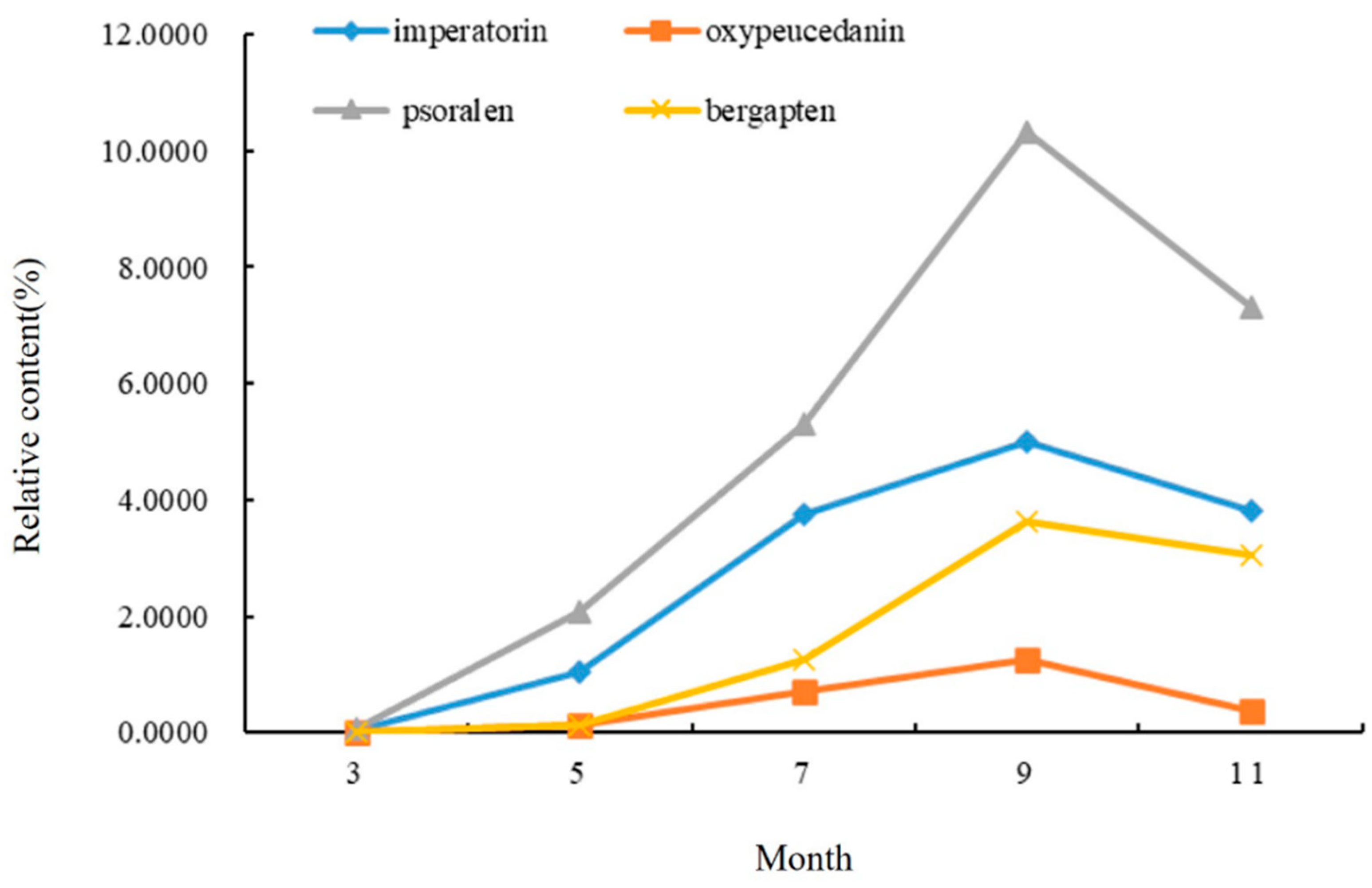

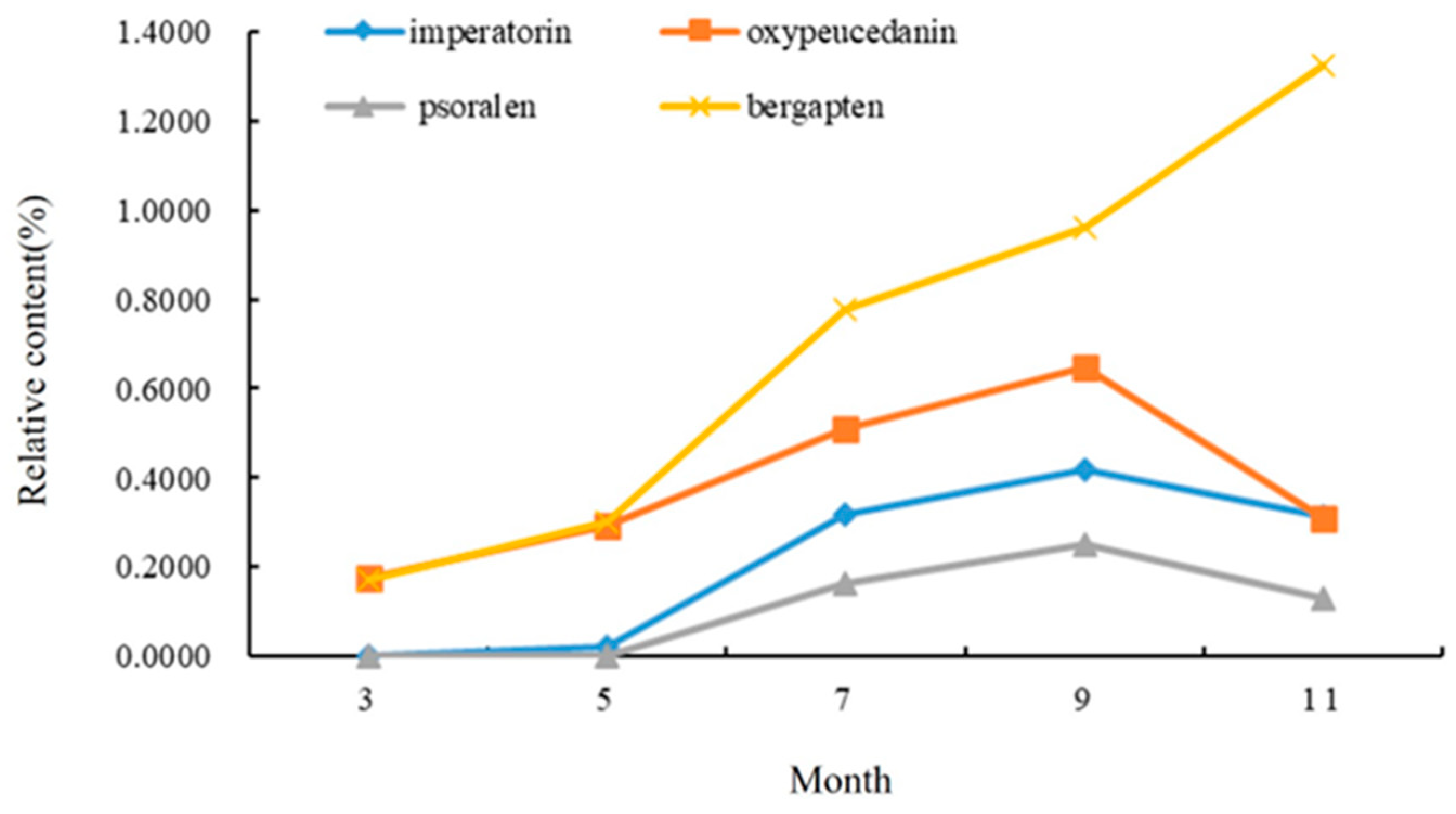
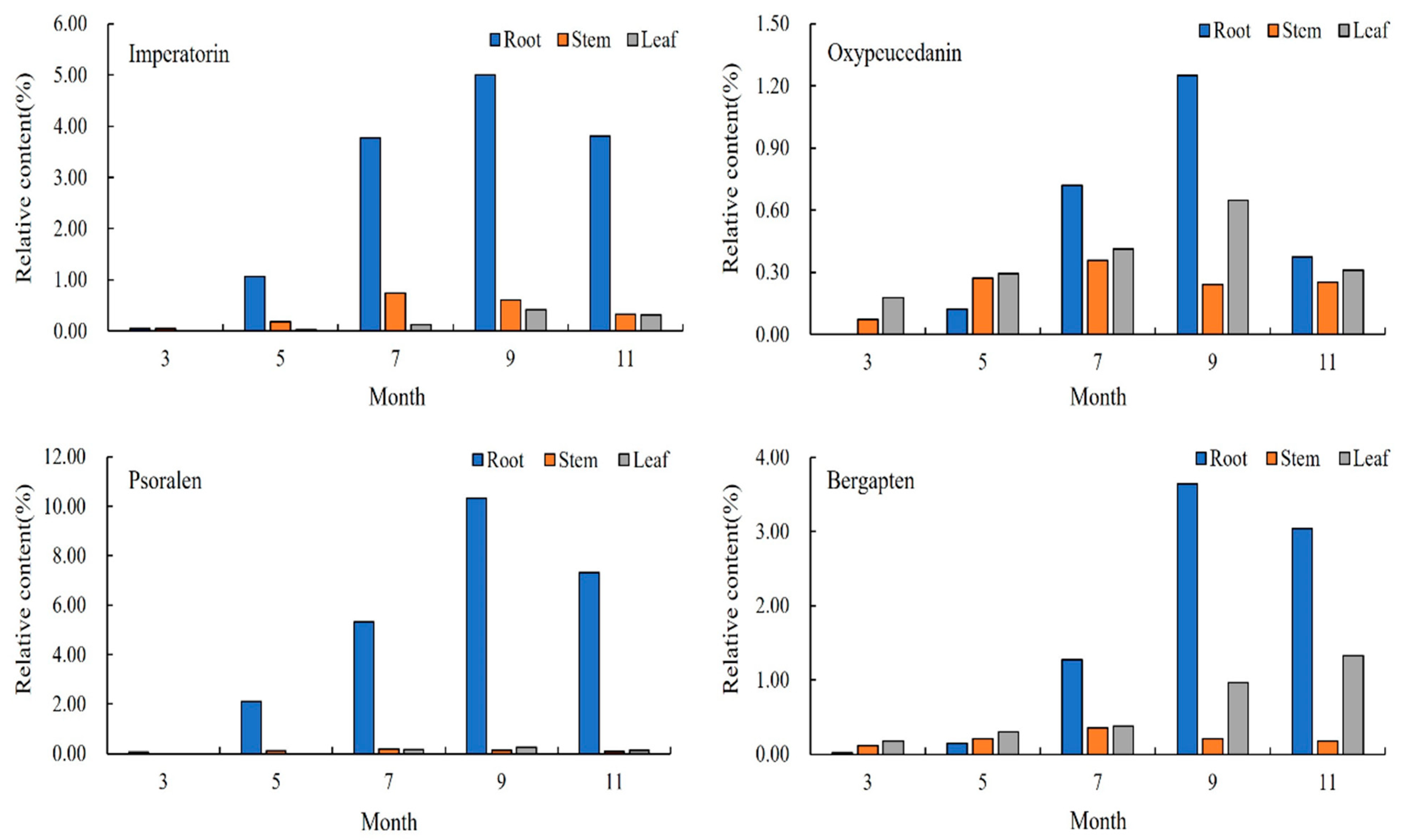
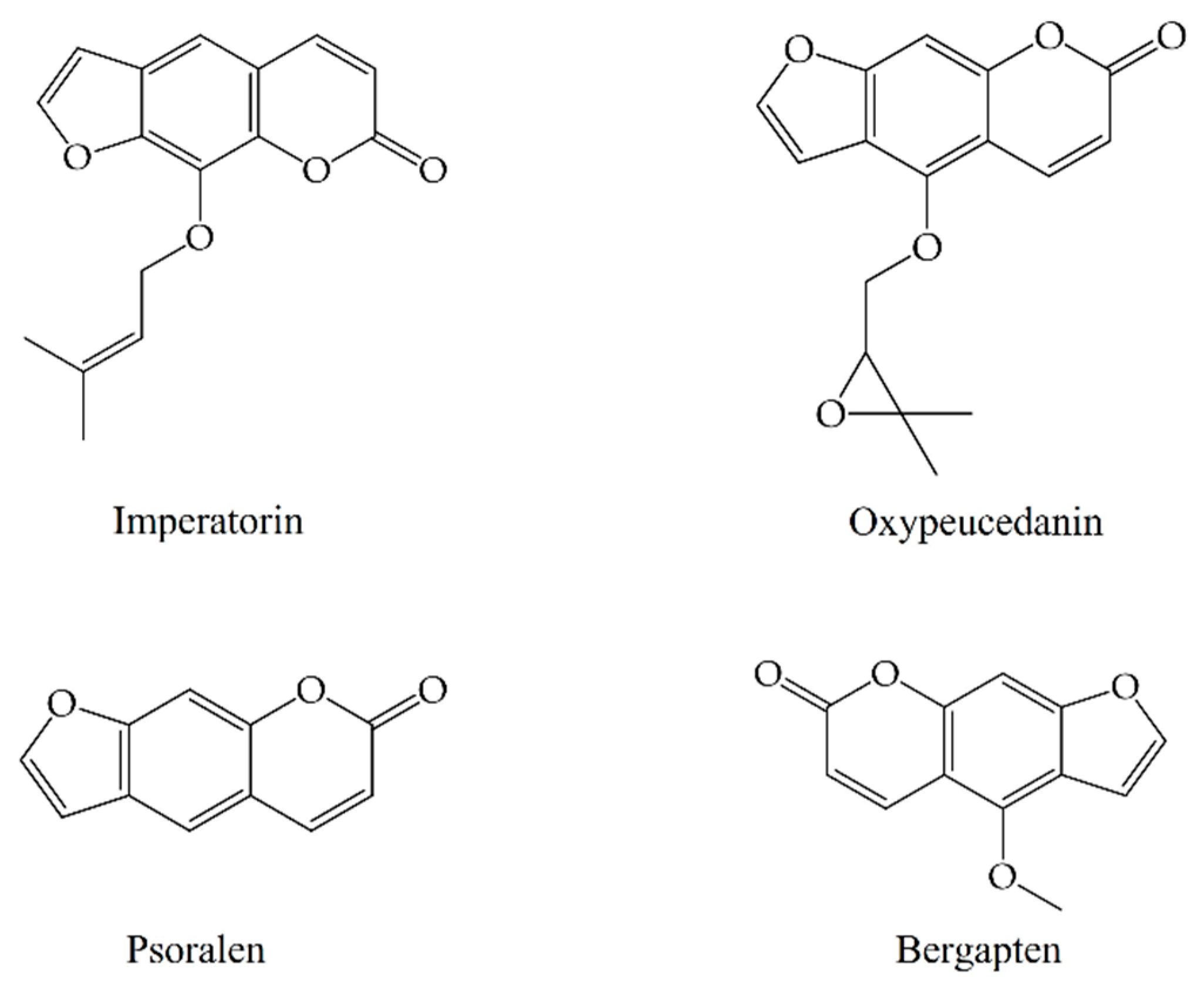


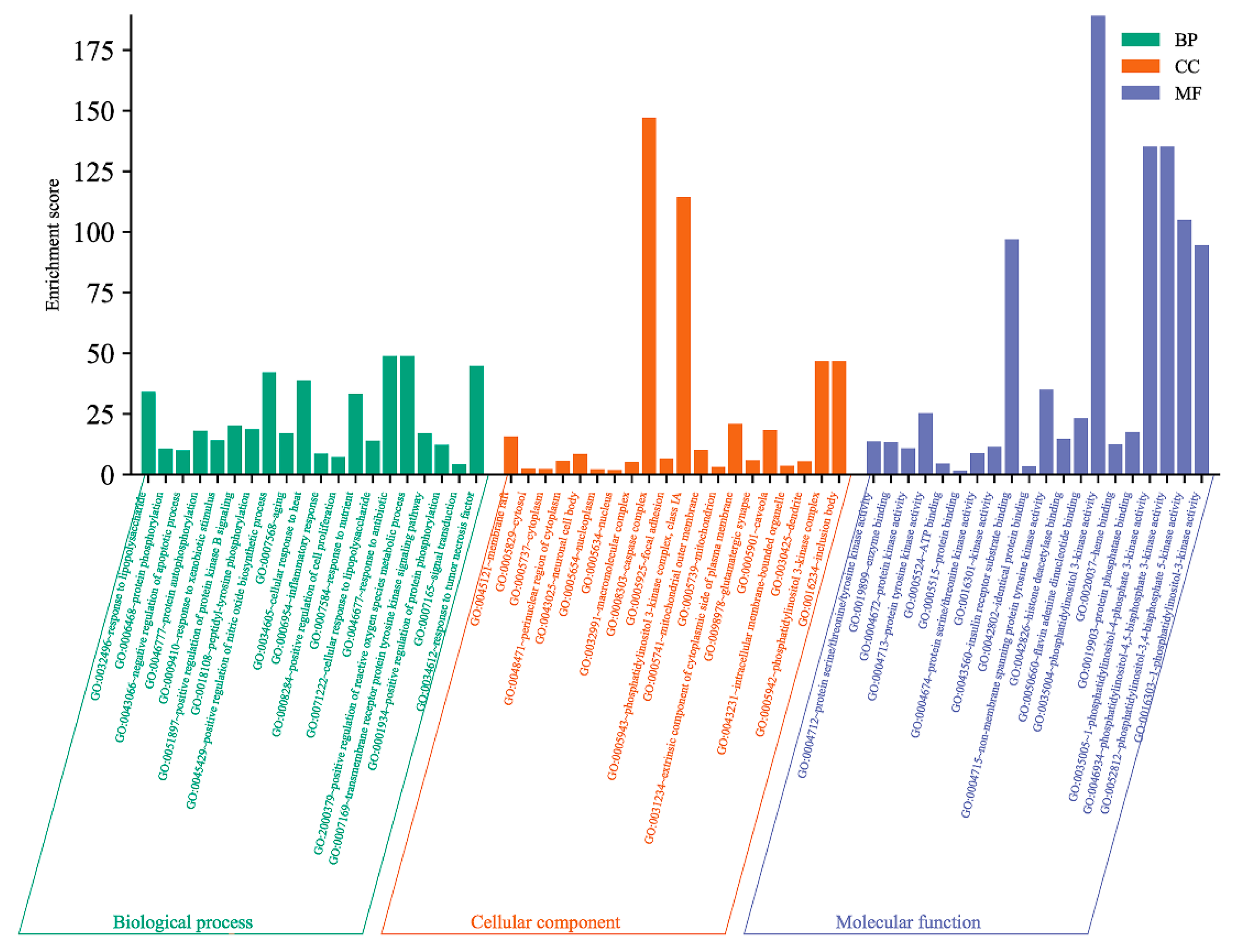
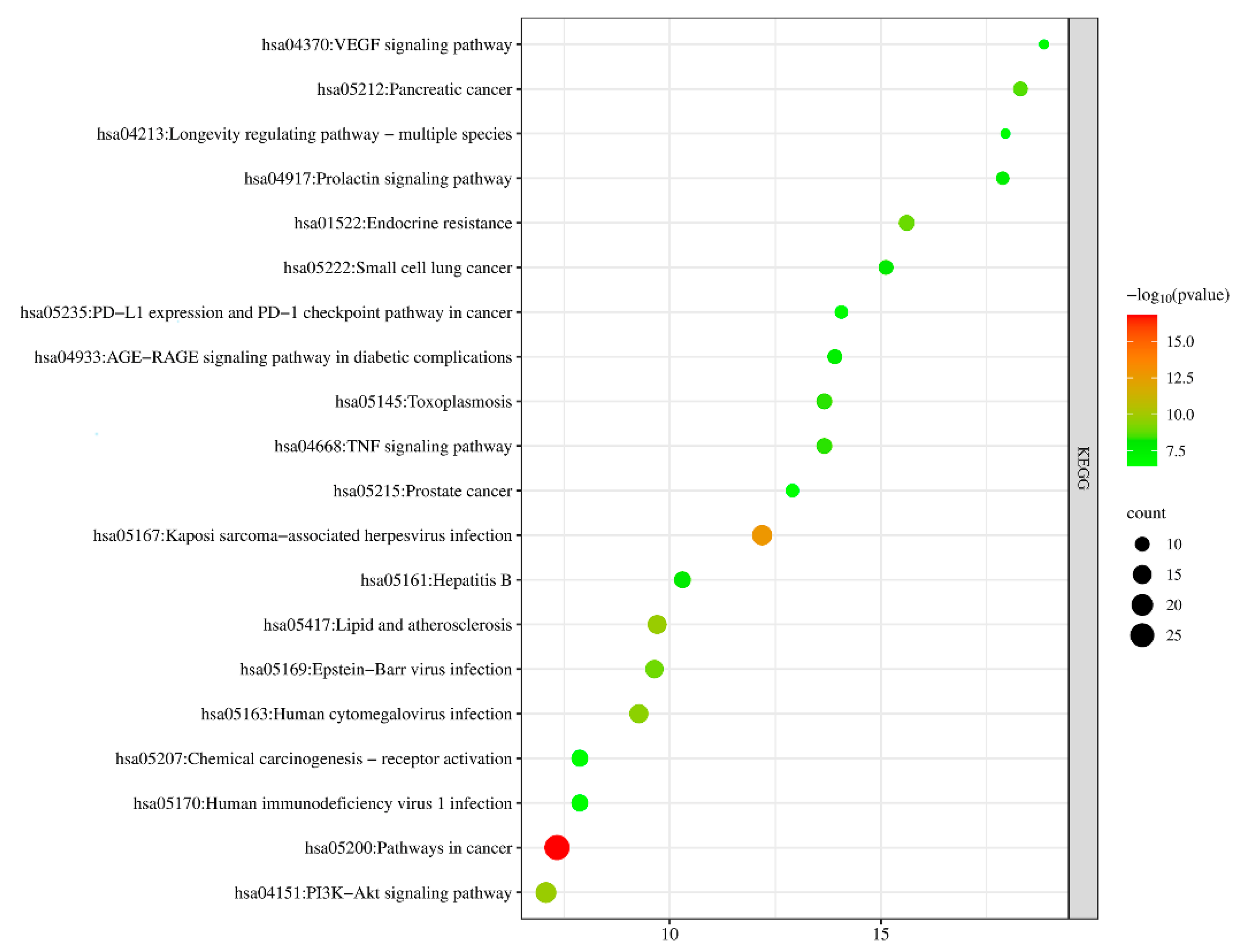
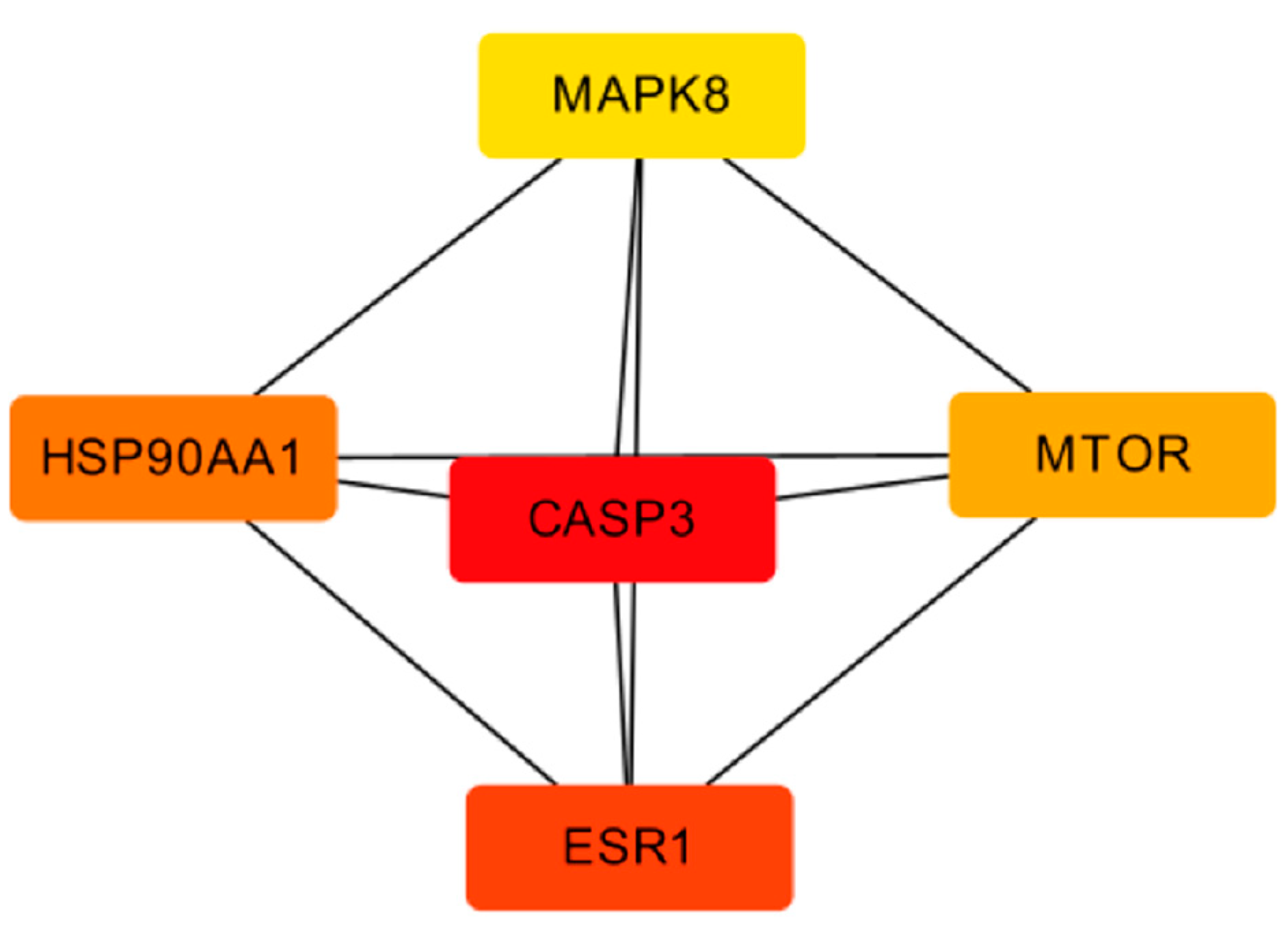
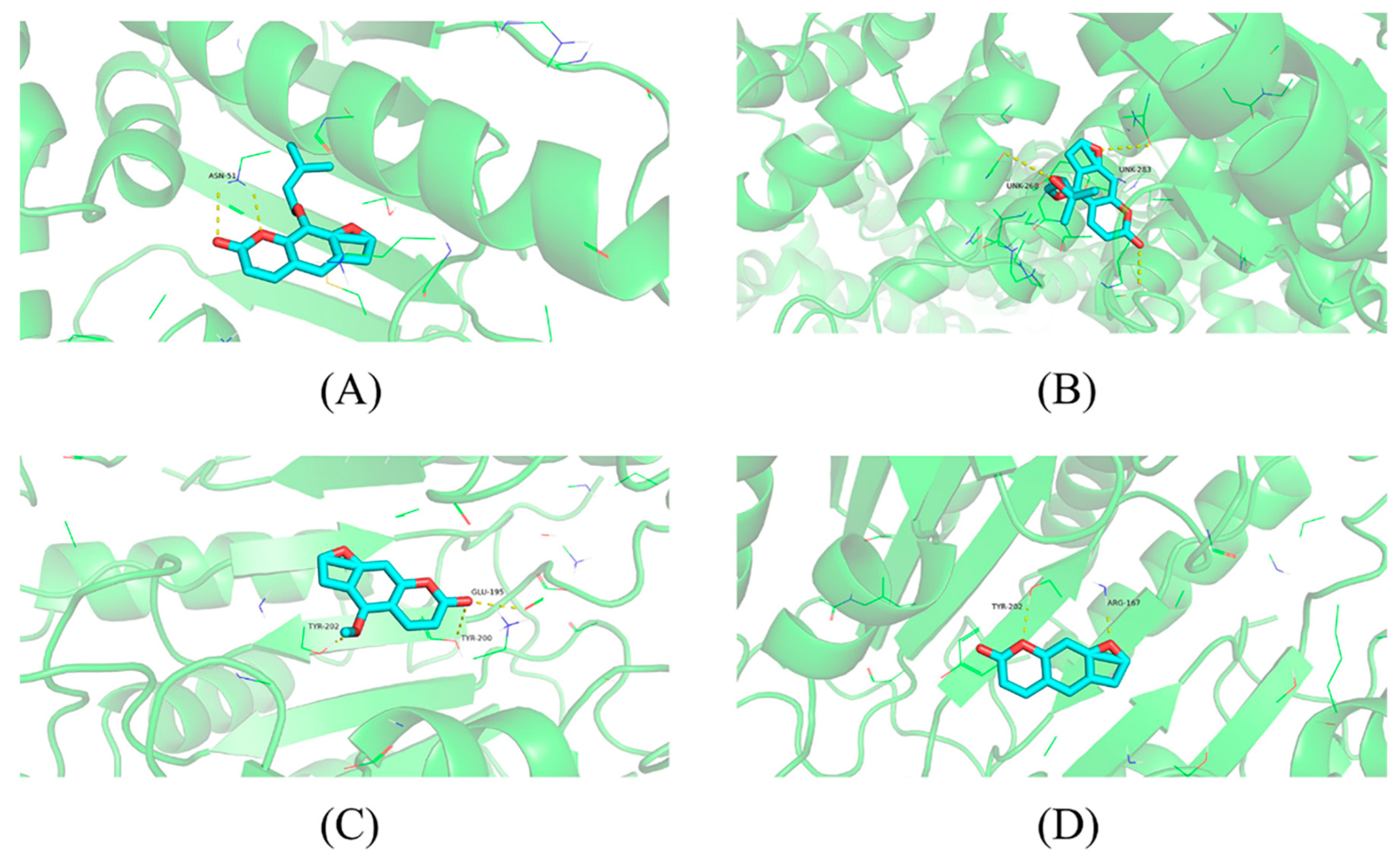
| No. | RT | Compound | Molecular Formula | Relative Content (%) | ||
|---|---|---|---|---|---|---|
| Root | Leaf | Stem | ||||
| 1 | 10.730 | Hexanal | C6H12O | 0.0630 | 0.0458 | 0.4852 |
| 2 | 11.065 | Phenyl α-D-glucopyranoside | C12H16O6 | 0.0618 | 0.2091 | - |
| 3 | 11.175 | 1-Heptanol | C7H16O | 0.3544 | 1.1326 | 0.1893 |
| 4 | 11.735 | Thymol | C10H14O | 0.0870 | 0.1836 | 0.2834 |
| 5 | 12.467 | 3-Carene | C10H16 | 4.6076 | 0.2972 | 0.2763 |
| 6 | 12.930 | 3-Furaldehyde | C5H4O2 | 2.7352 | 0.4450 | 0.1074 |
| 7 | 13.216 | Camphene | C19H16 | 0.0574 | 0.0574 | - |
| 8 | 13.770 | 3-Furanmethanol | C5H6O2 | 3.2033 | 2.2195 | 0.4839 |
| 9 | 14.032 | (1S)-(-)-β-Pinene | C10H16 | 1.1364 | 0.0125 | 0.4001 |
| 10 | 15.056 | 2-Butenoicacid,2-methyl-, (Z)- | C5H8O2 | 2.7235 | 0.4160 | 0.5282 |
| 11 | 15.117 | 3-Methylcrotonaldehyde | C5H8O | 3.4739 | 1.5817 | - |
| 12 | 15.410 | 2,6-Dimethylocta-2,7-dien-6-ol | C10H18O | 1.7658 | 0.2394 | 1.1417 |
| 13 | 15.562 | α-Phellandrene | C10H16 | 1.0273 | 0.4106 | 0.3924 |
| 14 | 16.884 | 4-Isopropylidene-1-methylcyclo | C10H16 | 0.8403 | - | 0.1160 |
| 15 | 17.774 | Borneol | C10H18O | 0.3705 | 0.1086 | 0.2096 |
| 16 | 19.718 | 4-Hydroxy-2,5-dimethyl-3(2H) furanone | C6H8O3 | 1.5613 | - | 0.8221 |
| 17 | 20.382 | Acetone Glucose | C9H16O6 | 0.0652 | 0.2013 | 0.0567 |
| 18 | 21.503 | 4,6-O-Ethylidene-α-D-glucose | C8H14O6 | 0.9665 | 0.3251 | - |
| 19 | 22.356 | Isopimpinellin | C13H10O5 | 0.5048 | 1.1532 | 0.9114 |
| 20 | 23.014 | Isolongifolene | C15H24 | 0.8128 | - | 0.0789 |
| 21 | 23.051 | Isobornyl acetate | C12H20O2 | 1.2771 | - | - |
| 22 | 23.143 | Nonanal | C9H18O7 | 0.0889 | 0.6421 | 0.3161 |
| 23 | 24.197 | Pimpinellin | C13H10O5 | 0.0828 | 0.2033 | - |
| 24 | 25.444 | 2-Hydroxy-5-methyl acetophenone | C9H10O2 | 3.5660 | 4.2425 | - |
| 25 | 25.988 | 5-Hydroxymethylfurfural | C6H6O3 | 3.6589 | 4.8772 | 0.3453 |
| 26 | 26.415 | 9-Hexadecenoic acid, (9Z)- | C16H30O2 | 1.1248 | - | 1.3593 |
| 27 | 26.805 | Vetiverol | C15H26O | 0.3599 | - | - |
| 28 | 26.823 | β-Eudesmol | C15H26O | 0.2134 | 1.0981 | 14.5071 |
| 29 | 27.055 | Angenomalin | C14H12O3 | 7.5490 | 0.7771 | - |
| 30 | 27.085 | Bisabolene | C15H24 | 2.0434 | 0.6263 | 0.6706 |
| 31 | 28.402 | Paeonol | C9H10O3 | 0.8024 | 0.4961 | 0.9929 |
| 32 | 29.005 | Acrylic acid tetradecyl ester | C17H32O2 | 0.7908 | - | 0.1187 |
| 33 | 29.249 | Bergapten | C12H8O4 | 3.6443 | 0.3544 | 0.9598 |
| 34 | 30.126 | Phellopterin | C17H16O5 | 0.2227 | 0.5170 | 0.2085 |
| 35 | 30.797 | 1-Hexadecene | C16H32 | 0.1534 | 0.3363 | 0.3949 |
| 36 | 30.803 | Phenyl stearate | C24H40O2 | 0.0939 | 2.4649 | - |
| 37 | 31.376 | Osthole | C15H16O3 | 1.4983 | 0.9714 | 0.6746 |
| 38 | 32.065 | (+)-Decursinol | C14H14O4 | 1.1992 | 0.5716 | 1.5293 |
| 39 | 33.619 | Imperatorin | C16H14O4 | 4.9971 | 0.7366 | 0.4191 |
| 40 | 33.997 | 2-Octylcyclopropaneoctanal | C19H36O | 0.2201 | 0.2357 | - |
| 41 | 34.198 | Pabulenol | C16H14O5 | 0.4830 | 0.2332 | 0.1453 |
| 42 | 35.417 | Isooxypeucedanin | C16H14O5 | 0.2401 | 0.4490 | 0.2430 |
| 43 | 35.581 | Isoimperatorin | C16H14O4 | 0.2248 | 0.2321 | - |
| 44 | 36.325 | Methyl hexadecanoate | C17H34O2 | 1.0761 | 1.0578 | 5.0586 |
| 45 | 36.520 | 11-Dodecen-1-ol acetate | C14H26O2 | 0.0066 | - | 0.1124 |
| 46 | 36.648 | Oxypeucedanin | C16H14O5 | 1.2500 | 0.3575 | 0.6478 |
| 47 | 38.184 | Byakangelicol | C17H16O6 | 0.2069 | 0.2795 | 0.1002 |
| 48 | 40.231 | Psoralen | C11H6O3 | 10.3183 | 0.1749 | 0.2499 |
| 49 | 40.445 | Angelicin | C11H6O3 | 0.4101 | - | - |
| 50 | 41.798 | 13-Octadecenal, (Z)- | C18H34O | 0.1218 | 0.0844 | - |
| 51 | 41.840 | Verbenalin | C17H24O | 0.0512 | - | 0.1104 |
| 52 | 42.023 | 1,2-Benzenedicarboxylic acid | C16H22O4 | 0.0543 | - | - |
| 53 | 42.096 | Byakangelicin | C17H18O7 | 0.1309 | 0.0391 | - |
| 54 | 42.535 | Dibutyl phthalate | C16H22O4 | 1.8615 | - | - |
| 55 | 43.669 | Methyl oleate | C19H36O2 | 0.6757 | 0.7178 | 0.7278 |
| 56 | 43.894 | Decursin | C19H20O5 | 3.8667 | 2.5107 | 1.4460 |
| 57 | 44.224 | Methyl Stearate | C19H38O2 | 0.7647 | 0.3617 | 1.0879 |
| 58 | 45.735 | Meranzin | C15H16O4 | 0.0411 | 0.3364 | - |
| 59 | 46.704 | Columbianadin | C19H20O5 | 1.0762 | 0.1896 | 0.4628 |
| 60 | 48.983 | 1,4-Benzenedicarboxaldehyde,2,5-bis(hexyloxy)- | C20H30O4 | 0.1152 | - | 0.1347 |
| 61 | 50.141 | Paullinic acid | C20H38O2 | 0.0291 | - | - |
| Part | March | May | July | September | November |
|---|---|---|---|---|---|
| Root | 22 | 42 | 54 | 61 | 49 |
| Leaf | 24 | 38 | 48 | 41 | 30 |
| Stem | 20 | 34 | 39 | 42 | 35 |
| NO. | Target | Common Name | Uniprot ID |
|---|---|---|---|
| 1 | Monoamine oxidase A | MAOA | P21397 |
| 2 | Acetylcholinesterase | ACHE | P22303 |
| 3 | Beta-secretase 1 | BACE1 | P56817 |
| 4 | Cytochrome P450 1A2 | CYP1A2 | P05177 |
| 5 | Cytochrome P450 19A1 | CYP19A1 | P11511 |
| 6 | MAP kinase p38 alpha | MAPK14 | Q16539 |
| 7 | Nitric oxide synthase, inducible | NOS2 | P35228 |
| 8 | Nerve growth factor receptor Trk-A | NTRK1 | P04629 |
| 9 | Histone deacetylase 2 | HDAC2 | Q92769 |
| 10 | Tyrosine-protein kinase JAK2 | JAK2 | O60674 |
| 11 | Histone deacetylase 1 | HDAC1 | Q13547 |
| 12 | Serine/threonine-protein kinase mTOR | MTOR | P42345 |
| 13 | PI3-kinase p110-beta subunit | PIK3CB | P42338 |
| 14 | PI3-kinase p110-gamma subunit | PIK3CG | P48736 |
| 15 | PI3-kinase p110-alpha subunit | PIK3CA | P42336 |
| 16 | Phosphodiesterase 5A | PDE5A | O76074 |
| 17 | Heat shock factor protein 1 | HSF1 | Q00613 |
| 18 | Muscle glycogen synthase | GYS1 | P13807 |
| 19 | Protein tyrosine kinase 2 beta | PTK2B | Q14289 |
| 20 | Monoamine oxidase B | MAOB | P27338 |
| 21 | MAP kinase-activated protein kinase 2 | MAPKAPK2 | P49137 |
| 22 | c-Jun N-terminal kinase 1 | MAPK8 | P45983 |
| 23 | Protoporphyrinogen oxidase | PPOX | P50336 |
| 24 | Prostanoid EP2 receptor | PTGER2 | P43116 |
| 25 | Butyrylcholinesterase | BCHE | P06276 |
| 26 | Cannabinoid receptor 1 | CNR1 | P21554 |
| 27 | Cyclooxygenase-1 | PTGS1 | P23219 |
| 28 | Cyclooxygenase-2 | PTGS2 | P35354 |
| 29 | Cannabinoid receptor 2 | CNR2 | P34972 |
| 30 | Dual specificity mitogen-activated protein kinase kinase 1 | MAP2K1 | Q02750 |
| 31 | Tyrosine-protein kinase JAK1 | JAK1 | P23458 |
| 32 | Platelet activating factor receptor | PTAFR | P25105 |
| 33 | Nuclear factor NF-kappa-B p105 subunit | NFKB1 | P19838 |
| 34 | Quinone reductase 1 | NQO1 | P15559 |
| 35 | Estrogen receptor alpha | ESR1 | P03372 |
| 36 | Ribosomal protein S6 kinase 1 | RPS6KB1 | P23443 |
| 37 | Poly [ADP-ribose] polymerase-1 | PARP1 | P09874 |
| 38 | Intercellular adhesion molecule-1 | ICAM1 | P05362 |
| 39 | Selectin E | SELE | P16581 |
| 40 | Endothelin receptor ET-B | EDNRB | P24530 |
| 41 | Endothelin receptor ET-A | EDNRA | P25101 |
| 42 | Heat shock protein HSP 90-alpha | HSP90AA1 | P07900 |
| 43 | Arachidonate 5-lipoxygenase | ALOX5 | P09917 |
| 44 | Leucine-rich repeat serine/threonine-protein kinase 2 | LRRK2 | Q5S007 |
| 45 | Androgen Receptor | AR | P10275 |
| 46 | Aldo-keto-reductase family 1 member C3 | AKR1C3 | P42330 |
| 47 | Caspase-3 | CASP3 | P42574 |
| 48 | Caspase-9 | CASP9 | P55211 |
| 49 | Caspase-7 | CASP7 | P55210 |
| 50 | Myeloperoxidase | MPO | P05164 |
| 51 | Cyclin-dependent kinase 2 | CDK2 | P24941 |
| 52 | Cyclin-dependent kinase 4 | CDK4 | P11802 |
| 53 | Xanthine dehydrogenase | XDH | P47989 |
| 54 | Aldo-keto reductase family 1 member C1 | AKR1C1 | Q04828 |
| 55 | Estrogen receptor beta | ESR2 | Q92731 |
| 56 | Aldose reductase | AKR1B1 | P15121 |
| 57 | Insulin receptor | INSR | P06213 |
| 58 | Focal adhesion kinase 1 | PTK2 | Q05397 |
| 59 | Tyrosine-protein kinase TIE-2 | TEK | Q02763 |
| 60 | Heat shock 70 kDa protein 1 | HSPA1A | P0DMV8 |
| 61 | Tyrosine-protein kinase Lyn (by homology) | LYN | P07948 |
| Target | Binding Energy (kcal/mol) | |||
|---|---|---|---|---|
| Imperatorin | Oxypeucedanin | Psoralen | Bergapten | |
| CASP3 | −7.3 | −5.0 | −6.6 | −6.5 |
| ESR1 | −7.3 | −5.5 | −6.3 | −6.8 |
| HSP90AA1 | −7.7 | −5.3 | −4.7 | −5.5 |
| MTOR | −7.4 | −6.5 | −6.4 | −6.3 |
| MAPK8 | −6.1 | −5.2 | −5.6 | −5.9 |
Disclaimer/Publisher’s Note: The statements, opinions and data contained in all publications are solely those of the individual author(s) and contributor(s) and not of MDPI and/or the editor(s). MDPI and/or the editor(s) disclaim responsibility for any injury to people or property resulting from any ideas, methods, instructions or products referred to in the content. |
© 2023 by the authors. Licensee MDPI, Basel, Switzerland. This article is an open access article distributed under the terms and conditions of the Creative Commons Attribution (CC BY) license (https://creativecommons.org/licenses/by/4.0/).
Share and Cite
Gao, H.; Li, Q. The Prediction of Antioxidant Q-Markers for Angelica dahurica Based on the Dynamics Change in Chemical Compositions and Network Pharmacology. Molecules 2023, 28, 5248. https://doi.org/10.3390/molecules28135248
Gao H, Li Q. The Prediction of Antioxidant Q-Markers for Angelica dahurica Based on the Dynamics Change in Chemical Compositions and Network Pharmacology. Molecules. 2023; 28(13):5248. https://doi.org/10.3390/molecules28135248
Chicago/Turabian StyleGao, Hui, and Qian Li. 2023. "The Prediction of Antioxidant Q-Markers for Angelica dahurica Based on the Dynamics Change in Chemical Compositions and Network Pharmacology" Molecules 28, no. 13: 5248. https://doi.org/10.3390/molecules28135248





